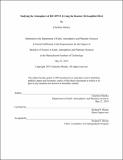| dc.contributor.advisor | Richard P. Binzel. | en_US |
| dc.contributor.author | Minsky, Charlotte(Charlotte L.) | en_US |
| dc.contributor.other | Massachusetts Institute of Technology. Department of Earth, Atmospheric, and Planetary Sciences. | en_US |
| dc.date.accessioned | 2021-03-22T17:12:59Z | |
| dc.date.available | 2021-03-22T17:12:59Z | |
| dc.date.copyright | 2019 | en_US |
| dc.date.issued | 2020 | en_US |
| dc.identifier.uri | https://hdl.handle.net/1721.1/130194 | |
| dc.description | Thesis: S.B., Massachusetts Institute of Technology, Department of Earth, Atmospheric, and Planetary Sciences, May, 2020 | en_US |
| dc.description | Cataloged from student-submitted PDF of thesis. "May 21 2019." | en_US |
| dc.description | Includes bibliographical references (pages 29-32). | en_US |
| dc.description.abstract | Transmission spectroscopy is a widely-used method for studying exoplanetary atmospheres. However, the differential data analysis techniques that are generally applied to high-resolution ground-based spectroscopic data are only sensitive to narrow spectral features and do not preserve broadband features. This makes them insensitive to the strong Rayleigh scattering slope of HD 189733 b that is due to possible atmospheric aerosols. The Rossiter-McLaughlin (RM) effect provides a way to probe broadband spectral features because its amplitude varies as a function of wavelength according to the effective planet radius. Previously, radial velocity (RV) variations caused by the RM effect were interpreted as being a tentative detection (2.5[sigma]) of the broadband scattering slope of HD 189733 b. We developed a new method that directly models the distortions in spectral lines (rather than the resulting RV variation) and applied this method to the same archival HARPS data that was used in the previous tentative detection. Here we will present this method and the ongoing work necessarily to problem-solve and fully implement it. | en_US |
| dc.description.statementofresponsibility | by Charlotte Minsky. | en_US |
| dc.format.extent | 32 pages | en_US |
| dc.language.iso | eng | en_US |
| dc.publisher | Massachusetts Institute of Technology | en_US |
| dc.rights | MIT theses may be protected by copyright. Please reuse MIT thesis content according to the MIT Libraries Permissions Policy, which is available through the URL provided. | en_US |
| dc.rights.uri | http://dspace.mit.edu/handle/1721.1/7582 | en_US |
| dc.subject | Earth, Atmospheric, and Planetary Sciences. | en_US |
| dc.title | Studying the atmosphere of HD 189733 b using the Rossiter-McLaughlin effect | en_US |
| dc.type | Thesis | en_US |
| dc.description.degree | S.B. | en_US |
| dc.contributor.department | Massachusetts Institute of Technology. Department of Earth, Atmospheric, and Planetary Sciences | en_US |
| dc.identifier.oclc | 1241180991 | en_US |
| dc.description.collection | S.B. Massachusetts Institute of Technology, Department of Earth, Atmospheric, and Planetary Sciences | en_US |
| dspace.imported | 2021-03-22T17:12:29Z | en_US |
| mit.thesis.degree | Bachelor | en_US |
| mit.thesis.department | EAPS | en_US |
